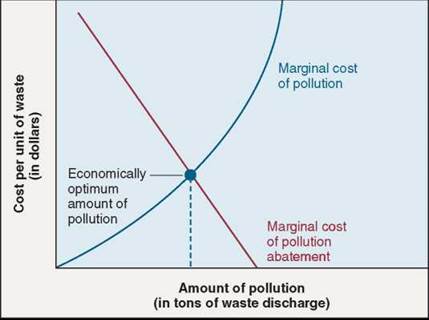THE LIVING WORLD
Unit Eight. The Living Environment
38. Human Influences on the Living World
The pattern of global change that is overtaking our world is very disturbing. Human activities are placing a severe stress on the biosphere, and we must quickly find ways to reduce the harmful impact. There are four key areas in which it will be particularly important to meet the challenge successfully: reducing pollution, finding other sources of energy, preserving nonreplaceable resources, and curbing population growth.
To solve the problem of industrial pollution, it is first necessary to understand the cause of the problem. In essence, it is a failure of our economy to set a proper price on environmental health. To understand how this happens, we must think for a moment about money. The economy of the United States (and much of the rest of the industrial world) is based on a simple feedback system of supply and demand. As a commodity gets scarce, its price goes up, and this added profit acts as an incentive for more of the item to be produced; if too much is produced, the price falls and less of it is made because it is no longer so profitable to produce it.
This system works very well and is responsible for the economic strength of our nation, but it has one great weakness. If demand is set by price, then it is very important that all the costs be included in the price. Imagine that the person selling the item were able to pass off part of the production cost to a third person. The seller would then be able to set a lower price and sell more of the item! Driven by the lower price, the buyer would purchase more than if all the costs had been added into the price.
Unfortunately, that sort of pricing error is what has driven the pollution of the environment by industry. The true costs of energy and of the many products of industry are composed of direct production costs, such as materials and wages, and of indirect costs, such as pollution of the ecosystem. Economists have identified an “optimum” amount of pollution based on how much it costs to reduce pollution versus the social and environmental cost of allowing pollution. The economically optimum amount of pollution is indicated by the blue dot in figure 38.8. If more pollution than the optimum is allowed, the social cost is too high, but if less than the optimum is allowed, the economic cost is too high.

Figure 38.8. Is there an optimum amount of pollution?
Economists identify the "optimum" amount of pollution as the point at which eliminating the next unit of pollution (the marginal cost of pollution abatement) equals the cost in damages caused by that unit of pollution (the marginal cost of pollution).
The indirect costs of pollution are usually not taken into account. However, the indirect costs do not disappear because we ignore them. They are simply passed on to future generations, which must pay the bill in terms of damage to the ecosystems on which we all depend. Increasingly, the future is now. Our world, unable to support more damage, is demanding that something be done—that we finally pay up.
Antipollution Laws
Two effective approaches have been devised to curb pollution in this country. The first is to pass laws forbidding it. In the last 20 years, laws have begun to significantly curb the spread of pollution by setting stiff standards for what can be released into the environment. For example, all cars are required to have effective catalytic converters to eliminate automobile smog. Similarly, the Clean Air Act of 1990 requires that power plants eliminate sulfur emissions. They can accomplish this by either installing scrubbers on their smokestacks or by burning low-sulfur coal (clean-coal technology), which is more expensive. The effect is that the consumer pays to avoid polluting the environment. The cost of the converters makes cars more expensive, and the cost of the scrubbers increases the price of the energy. The new, higher costs are closer to the true costs, lowering consumption to more appropriate levels.
Pollution Taxes
A second approach to curbing pollution has been to increase the consumer costs directly by placing a tax on the pollution, in effect an artificial price hike imposed by the government as a tax added to the price of production. This added cost lowers consumption too, but by adjusting the tax, the government can attempt to balance the conflicting demands of environmental safety and economic growth. Such taxes, often imposed as “cap-and-trade pollution permits,” are becoming an increasingly important part of antipollution laws.
Key Learning Outcome 38.6. Free market economies often foster pollution when prices do not include environmental costs. Laws and taxes are being designed in an attempt to compensate.